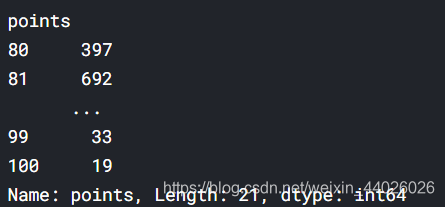pandas的应用(四) Grouping and Sorting
1. group
One function we’ve been using heavily thus far is the value_counts() function. We can replicate what value_counts() does by doing the following:
reviews.groupby('points').points.count()

groupby() created a group of reviews which allotted the same point values to the given wines. Then, for each of these groups, we grabbed the points() column and counted how many times it appeared. value_counts() is just a shortcut to this groupby() operation.
We can use any of the summary functions we’ve used before with this data. For example, to get the cheapest wine in each point value category, we can do the following:
reviews.groupby('points').price.min()
You can think of each group we generate as being a slice of our DataFrame containing only data with values that match. This DataFrame is accessible to us directly using the apply() method, and we can then manipulate the data in any way we see fit. For example, here’s one way of selecting the name of the first wine reviewed from each winery in the dataset:
reviews.groupby('winery').apply(lambda df: df.title.iloc[0])
For even more fine-grained control, you can also group by more than one column. For an example, here’s how we would pick out the best wine by country and province:
reviews.groupby(['country', 'province']).apply(lambda df: df.loc[df.points.idxmax()])

Another groupby() method worth mentioning is agg(), which lets you run a bunch of different functions on your DataFrame simultaneously. For example, we can generate a simple statistical summary of the dataset as follows:
reviews.groupby(['country']).price.agg([len, min, max])

2. Multi-indexes
In all of the examples we’ve seen thus far we’ve been working with DataFrame or Series objects with a single-label index. groupby() is slightly different in the fact that, depending on the operation we run, it will sometimes result in what is called a multi-index.
A multi-index differs from a regular index in that it has multiple levels. For example:
countries_reviewed = reviews.groupby(['country', 'province']).description.agg([len])
countries_reviewed

However, in general the multi-index method you will use most often is the one for converting back to a regular index, the reset_index() method:
countries_reviewed.reset_index()

3. Sorting
Looking again at countries_reviewed we can see that grouping returns data in index order, not in value order. That is to say, when outputting the result of a groupby, the order of the rows is dependent on the values in the index, not in the data.
To get data in the order want it in we can sort it ourselves. The sort_values() method is handy for this.
countries_reviewed = countries_reviewed.reset_index()
countries_reviewed.sort_values(by='len')

sort_values() defaults to an ascending sort, where the lowest values go first. However, most of the time we want a descending sort, where the higher numbers go first. That goes thusly:
countries_reviewed.sort_values(by='len', ascending=False)
To sort by index values, use the companion method sort_index(). This method has the same arguments and default order:
countries_reviewed.sort_index()

Finally, know that you can sort by more than one column at a time:
countries_reviewed.sort_values(by=['country', 'len'])

例子:
What are the minimum and maximum prices for each variety of wine? Create a DataFrame whose index is the variety category from the dataset and whose values are the min and max values thereof.
price_extremes = reviews.groupby('variety').price.agg([min, max])